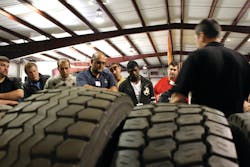Here are some of the personas and conditions that are the worst offenders when it comes to properly choosing, maintaining and operating a truck tire. If they’re in your organization, they are doing both your tires and your operations a disservice.
The Optimist – This type believes that checking tire air pressure twice a week just isn’t necessary, and may even believe they can tell tire is low just by looking at it.
As tire manufacturers, we can’t emphasize proper air pressure enough. Low air inflation is the top cause of premature tire removal and slow leaks cause 90 percent of tire failures.
According to Kevin Naumann, Continental’s senior technical trainer: “Just 10 psi of underinflation is enough to cost you 9 to 15 percent of the tire’s tread wear and up to 1 percent fuel loss.”
“Hey, Watch This” – Despite the risks, a few technicians will occasionally take shortcuts with tire safety or engage in downright dangerous practices; typically, failure to use safety cages for inflation, using chemicals – even gasoline or lighter fluid – to seat beads and exceeding 40 psi to seat a bead or leaning over the tire while you do it. This is often the case when under pressure to get the job done quickly.
Old Faithful – Tire equipment that is old or improperly maintained can be robbing the life of your tires and even making them susceptible to damage. Consider the ubiquitous air gauge, for example. Just because it’s been your trusted air gauge for years doesn’t mean it is accurate.
“We estimate that 15 to 20 percent of all truck tire air gauges in use today are inaccurate by up to 15 psi,” says Naumann. Checking gauges against a calibrated master gauge should be on your list of frequent equipment checks in the maintenance bay.
The Bargain Hunter – It’s human nature to look for the best deal out there, but is a bargain basement truck tire really a good bet? Not when it comes to the total cost of ownership. Not only are premium brand truck tires more likely to have longer removal miles and save fuel, they’re also more retreadable, thanks to better belt packages and bead designs, as well as sidewall strength.
Even if your fleet doesn’t believe in retreading, you’d be throwing away money if you can’t sell your casings.
The Diesel Demon – When you consider that fuel is a fleet’s second largest cost after salaries, long-haul or combined long-haul and regional applications might find that a low rolling resistance tire is their best bet. We like to say that a fuel-efficient tire will trump a mileage tire every time, as long as diesel stays above $3.29 a gallon.
While tire manufacturers will continue to offer long-mileage tires with very deep treads, take a good look at your fuel costs and see if a low rolling resistance tire will save you more.
The “Sharp Dressed Man” – While the shop may be impeccable, what is the condition of the yard? Fleets may not realize they have a veritable knife collection lurking all around the yard with all types of metal, nails and other sharp debris. Make yard maintenance a component of regular facility maintenance.
Tire Conditions
Here are a few of the common types of wear concerns:
The Ballerina – Toe placement matters in ballet and in truck tires. A truck’s toe - the distance apart of the steer tires at the front and the rear – is a major cause of irregular tire wear. An optimal toe setting prevents inside tire wear (toe-out – the tires are closer together in the rear than in the front) or outside tire wear (toe-in – the tires are closer together in the front than in the rear).
Mr. Wrong – Today’s truck tire offerings are very diverse, designed to meet market conditions. Sometimes, though, the tire specified by a fleet is in its correct application but isn’t right for the operation. Consequently, the tire will usually experience irregular wear, robbing it of mileage and even fuel efficiency.
The Limbo Rock – How low can you go? Not only is trying to get a tire to wear down to the last legal 32nds of tread depth a bad idea, you may be short-changing yourself. The retreadability of the casing goes up if the tire is pulled before it reaches the legal limit.
Bear With Me – Wheel bearings affect tire wear. If the steer axle wheel bearings are loose, for example, the vehicle’s toe can start to vary – sometimes as much as 1/4", resulting in tire cupping. Listen to the wheel for bad bearings (a rumbling sound) while spinning the tire to check for run out.
Irreconcilable Differences – Mismatching is neither good for couples, nor for truck tires. Mismatched inflation air pressures in duals can cause a permanent irregular wear pattern in as little as just weeks.
Dual mismatch tread depths (which create tire height differences) cause also irregular wear that costs money in premature removal. In addition, the taller tire will become over fatigued due to bearing more weight, which accelerates premature casing failure.
If you remember to avoid this dirty 11, you’ll find that you’ll gain more life out of your tire investment.
Make sure to attend any seminars or trainings offered by your tire manufacturer so you can learn even more characteristics and behaviors of truck tires. It is always good business to consult with your tire representative on tire matters
About the Author
Jackie Pobiega
Continental Truck Tires, Communications Manager
Jackie Pobiega is the communication manager for truck and industrial tires at Continental Tire the Americas (www.continental-truck.com) in Fort Mill, SC. The company manufactures and distributes a complete premium line of passenger, light truck and commercial tires for original equipment and replacement markets.
